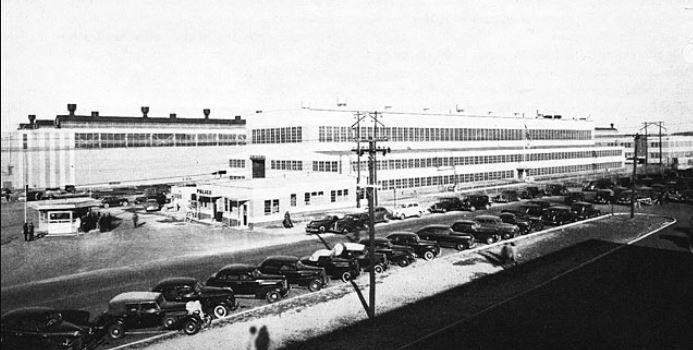Hingham Municipal Lighting Plant MA 1941. Bethlehem Steel Shipyard, K-frame Pole Line
By Joe Maurath, Jr.; posted July 29, 2020
View Original: Click to zoom, then click to magnify (693 x 350) 54KB

|
The latter type of construction as far as I know was unique to the New England Power (N.E.P.) Service Company (parent of the Weymouth Light and Power Company and others here in Massachusetts) who built this double circuit 13.2 kv transmission line (in the background) to this large ship-building complex in Hingham, Massachusetts during 1941-1942. The buildings were immense and extended for nearly a mile on the northern side of Lincoln Street (MA State Route 3A). This facility required an enormous amount of electricity within the numerous large buildings for crane operation, electric welding, etc. This image is only a portion probably because of government photography restrictions during wartime years. One 13.2 kv feed went into an indoor substation on the westerly end and the other into a similar brick structure on the easterly part of the property. All of this was quite impressive to look at! In summary the US government sold pieces of these lots through the years. Most of the buildings are gone now, replaced by condominiums, shops, restaurants and boat docks. As the old buildings were demolished the other ones still standing were bought and sold by private entities, adding customer base to the Hingham system. Some of the items from the original system from 1941-42 that served this WW2 complex such as metering, insulators, switching, etc, were preserved by me and will be added to the Picture Poster in the near future. The New England Electric System (Massachusetts Electric) sold all their property and interests on the Hingham side of the town line in 1965. Hingham resides by the coastline and during the WW1 and WW2 years was a perfect location for shipbuilding and weapons storage. This was very convenient for Uncle Sam but not quite so for Hingham, MA residents. They were quite shaky about the ammunition storage and shipbuilding near their coastline. The Hingham Municipal Light Board commented in their year-end 1941 report: "Careful consideration has been given to England's experience under war conditions. They report "cables and overhead distribution lines have not been disrupted by bombing anywhere near as much as have gas mains. Furthermore repairs to electric facilities are made more quickly" and "there have been only isolated and temporary instances of a few houses being without electricity for a day after a raid." In view of their experience the Board did not feel that a heavy investment in portable generating stations was necessary. Any bombing should cause only a fraction of the trouble we are always prepared for from storms or hurricanes and with emergency supplies at several different points, only the destruction of the generating plants should cause any long interruptions of service." Hopefully this eased anxieties for the forementioned townsfolk during the war period. Upcoming postings here within this column will provide additional info and electric utility-related activities during the wartime years. It is certain that other power companies along the East Coast were experiencing very similar challenges............ During 1941 the Light Plant was in need of a strong, confident person to add to their line crew. After reviewing numerous candidates, Mr. Clyde H. Curtis was hired by the Light Board. He absolutely loved utility lines, doing strong work and always was regarded having "old school" ethics. Born in Hingham, he worked in the field until 1957 when the Municipal Light Board hired him as General Manager. He held that position until 1981. Clyde was known as "Boomer" (nickname for aspiring linemen). Having known him rather well he has shared a lot of memories with me and they are included among my postings about this town-owned electric utility. Otherwise they would probably be gone and lost forever.... |